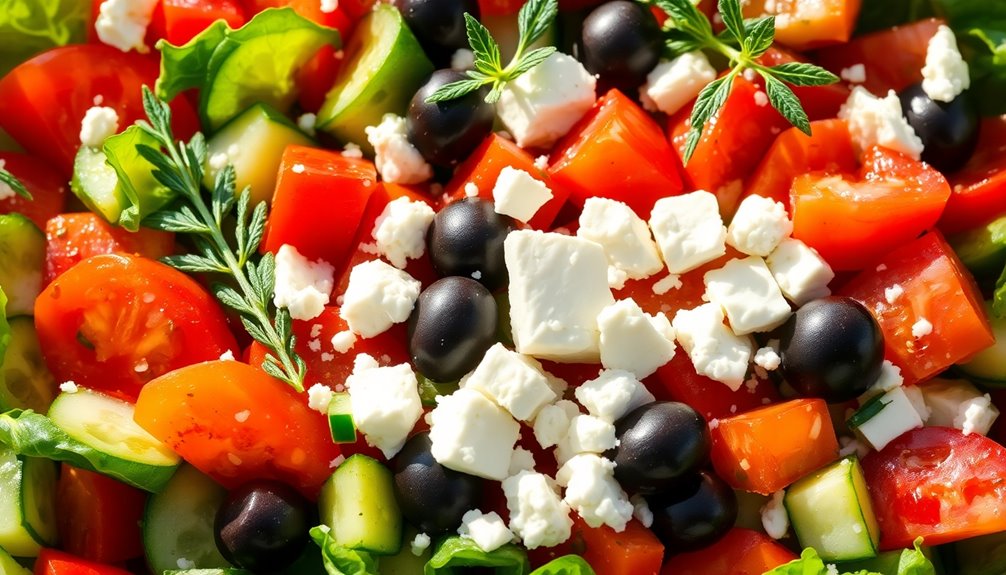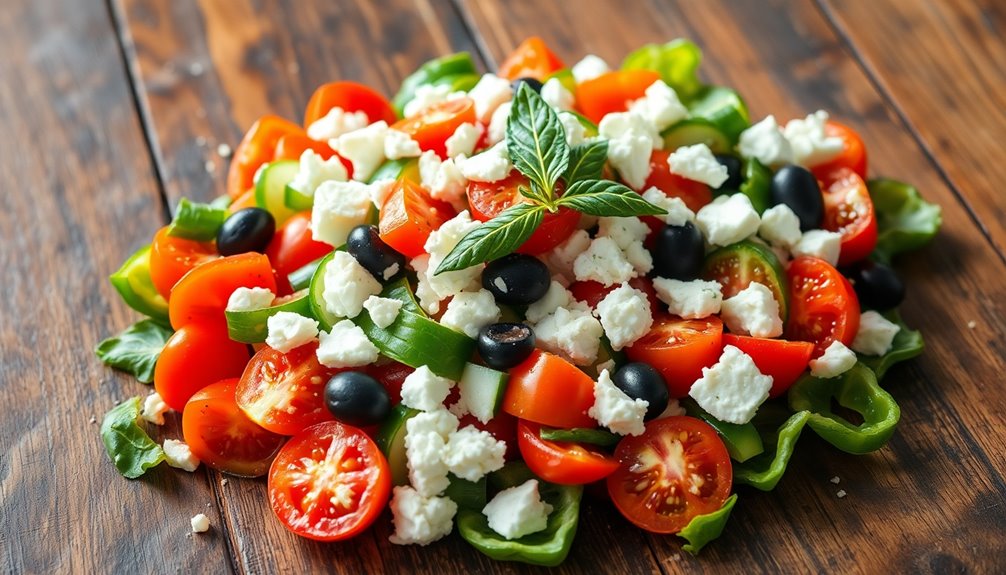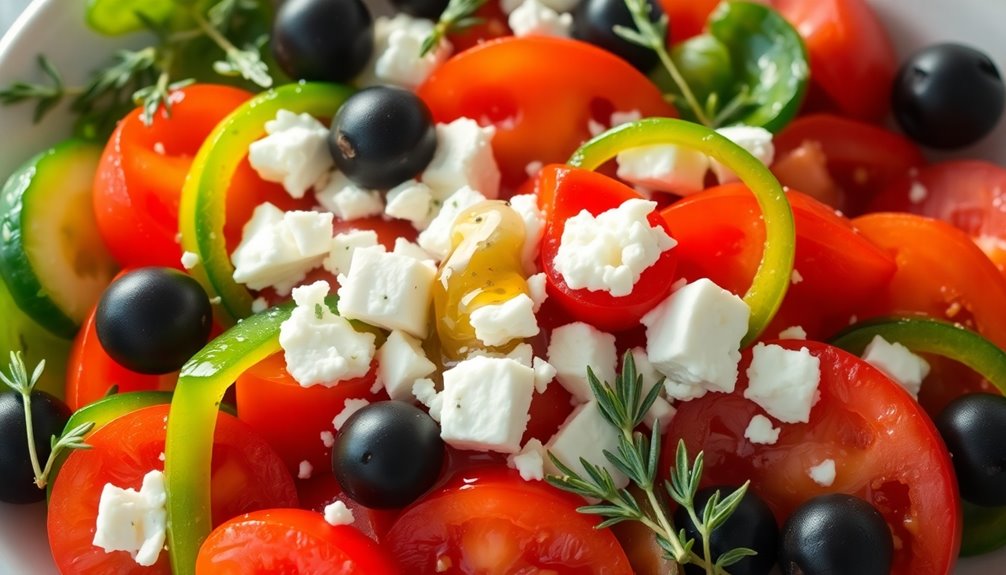Greek salad, or Horiatiki, is a vibrant dish that combines fresh tomatoes, cucumbers, bell peppers, red onions, Kalamata olives, and creamy feta cheese. It's known for its simple yet tasty Mediterranean flavors, making it perfect for warm weather and quick meals. With a drizzle of olive oil and a sprinkle of oregano, it brings out the best in each ingredient. If you're curious about its history and how to prepare it perfectly, there's even more to explore!
History

Greek salad, or Horiatiki, has roots in the rural regions of Greece, where it emerged as a dish celebrating fresh, seasonal ingredients without leafy greens.
Greek salad, or Horiatiki, originated in rural Greece, showcasing fresh, seasonal ingredients without the addition of leafy greens.
In the 1960s, it gained popularity and became a staple in Greek tavernas, embodying the Mediterranean diet's emphasis on fresh ingredients and healthy fats.
The inclusion of feta cheese highlights Greece's rich history of cheese-making, which dates back to ancient times.
Kalamata olives, known for their rich flavor and health benefits, are named after the city of Kalamata in the Peloponnese.
Over time, Greek salad has evolved, with variations reflecting local agricultural practices, yet it consistently retains its core elements, making it a beloved dish both in Greece and beyond.
Recipe

Greek salad, also known as Horiatiki, is a vibrant and refreshing dish that embodies the flavors of the Mediterranean. This salad is a perfect balance of fresh vegetables, savory feta cheese, and briny olives, making it a delightful option for any meal. The simplicity of the ingredients allows each flavor to shine, while the accompanying dressing adds a zesty kick that elevates the overall taste. Ideal for warm weather or as a side dish, Greek salad offers both nourishment and satisfaction.
Making Greek salad is straightforward and can be tailored to your preferences. With its mix of colorful vegetables and hearty feta, this salad not only pleases the palate but also provides a feast for the eyes. The preparation is quick, making it an excellent choice for busy weeknights or gatherings with friends and family. Follow the recipe below for a delicious and classic Greek salad that you can enjoy anytime.
Ingredients:
- 2 ripe tomatoes, cut into wedges
- 1 cucumber, peeled and diced
- 1 green bell pepper, sliced
- 1 red bell pepper, sliced
- 1 small red onion, thinly sliced
- 1 cup Kalamata olives
- 200g feta cheese, crumbled or in blocks
- 1/4 cup olive oil
- 2 tablespoons red wine vinegar
- 1 teaspoon Dijon mustard
- 1 clove garlic, minced
- 1 teaspoon dried oregano
- Salt and pepper to taste
To prepare the Greek salad, start by soaking the sliced red onions in a bowl of ice water mixed with a splash of vinegar for about 10 minutes to mellow their flavor. While the onions soak, chop the tomatoes, cucumber, bell peppers, and crumble the feta cheese into a large salad bowl.
Once the onions are ready, drain them and add to the bowl along with the Kalamata olives. In a separate small bowl, whisk together the olive oil, red wine vinegar, Dijon mustard, minced garlic, dried oregano, and a pinch of salt and pepper. Drizzle the dressing over the salad and gently toss everything together to combine.
For the best results, prepare the dressing a few days in advance to allow the flavors to meld. When assembling the salad, you can customize the ratio of vegetables and cheese to suit your taste. If you prefer a bolder flavor, consider adding more feta or olives.
To keep the salad fresh, it's best to combine the dressing with the salad ingredients just before serving. Leftovers can be stored in the fridge for up to 4 to 5 days, making this dish an excellent option for meal prep and quick meals. Enjoy your delicious Greek salad!
Cooking Steps

To make a delicious Greek salad, you'll start by chopping fresh vegetables finely.
Next, you'll add crumbled feta cheese and drizzle everything with olive oil.
Finally, season with oregano and pepper, then toss to combine all the vibrant flavors.
Step 1. Chop Fresh Vegetables Finely

When preparing a delicious Greek salad, chopping the fresh vegetables finely is essential for both texture and flavor.
Start with the cucumbers, slicing them into thin rounds or half-moons after seeding to keep your salad from getting soggy.
Next, chop ripe tomatoes into bite-sized pieces, using Roma or vine-ripe varieties for their firmness.
For bell peppers, cut them into small, uniform pieces, mixing green and red for added color and sweetness.
Don't forget the red onion—slice it thinly, or soak the slices in ice water with vinegar for about 10 minutes to mellow their flavor.
Finally, combine all the chopped ingredients in a large bowl, ensuring similar sizes for balanced bites and an appealing presentation.
Step 2. Add Feta Cheese Crumbles

Once you've finely chopped all your fresh vegetables, it's time to add feta cheese crumbles to elevate your salad.
For a traditional Greek salad, use about 1 cup of crumbled feta cheese, preferably quality Greek sheep's milk feta that comes in brine. This adds a rich, creamy flavor that perfectly complements your vibrant vegetables.
Crumble the feta into large chunks for the best presentation and texture. To enhance the flavor even more, consider sprinkling some dried oregano over the feta before serving.
If you'd like a vegan option, you can substitute feta with avocado, but keep in mind this will change the overall flavor profile of your dish.
Enjoy your deliciously fresh Greek salad!
Step 3. Drizzle With Olive Oil

Drizzling olive oil over your Greek salad is essential for bringing all the flavors together. For the best Greek salad, use high-quality extra virgin olive oil to enhance flavor and ensure a fresh and vibrant taste. Olive oil is also known for its health benefits, which include being rich in antioxidants and supporting bee health through its nutrient-rich profile.
Combine it with red wine vinegar in a ratio of 3 parts olive oil to 1 part vinegar for a balanced dressing. Aim for about 6 tablespoons of olive oil, but adjust based on your personal taste and the amount of salad ingredients, like juicy tomatoes and crisp cucumbers.
To ensure even distribution, whisk the olive oil with the vinegar in a small bowl before you drizzle it over your simple Greek salad. This step elevates your homemade Greek salad dressing and ties everything together beautifully. Incorporating healthy fats from olive oil can also support digestive health, making your meal even more beneficial.
Step 4. Season With Oregano and Pepper

To elevate your Greek salad, sprinkle about 1 teaspoon of dried oregano over the ingredients. This herb is a traditional component, enhancing the flavors of fresh vegetables like cucumbers, tomatoes, and bell peppers.
Next, add freshly ground black pepper to taste; this seasoning provides a subtle heat that complements the creamy feta and tangy Kalamata olives. The combination of oregano and black pepper not only boosts flavor but also contributes to the authenticity of your summer salad.
For an extra touch, consider garnishing with additional oregano just before serving, enhancing both the aroma and presentation.
With these simple steps, you'll create a delicious dressing that celebrates the essence of a classic Greek salad, making every bite memorable.
Step 5. Toss to Combine Ingredients

After seasoning your ingredients with oregano and pepper, it's time to bring everything together.
Start by adding all your prepped salad ingredients—chopped cucumbers, tomatoes, bell peppers, red onion, olives, and feta cheese—into a large mixing bowl.
Drizzle your prepared dressing over the mixture, ensuring it evenly coats all the fresh ingredients.
Now, use gentle folding motions to toss the salad, being careful not to break apart the feta or make it watery.
Your goal is a consistent mix where each bite delivers a balanced amount of vegetables, olives, and feta for optimal flavor.
Serve immediately after tossing to maintain the freshness and vibrant crunch of your Greek salad.
Enjoy every bite!
Final Thoughts

While enjoying a Greek salad, you can't help but appreciate its fresh flavors and vibrant colors, which perfectly embody the essence of summer.
This classic Greek salad, featuring a vibrant mix of cucumbers, tomatoes, bell peppers, onions, and Kalamata olives, is an easy summer dish that's both delicious and healthy.
With a simple homemade dressing of olive oil, red wine vinegar, garlic, and oregano, it enhances the fresh ingredients beautifully. You can easily make it ahead of time, keeping the dressing separate to maintain freshness.
A simple homemade dressing of olive oil, red wine vinegar, garlic, and oregano elevates the fresh ingredients perfectly.
Whether it's a light lunch or a summer side at your gatherings, Greek salad delivers a burst of vitamins and minerals, making it an ideal choice for healthy meals.
Enjoy!
Frequently Asked Questions
What Is in a Traditional Greek Salad?
Think of a vibrant canvas, where fresh ingredients dance together in perfect harmony.
A traditional dish like this features juicy tomatoes, crisp cucumbers, colorful bell peppers, zesty red onion, briny Kalamata olives, and creamy feta cheese.
You'll want to choose the ripest tomatoes and the finest feta for an unforgettable taste.
A simple dressing of olive oil, red wine vinegar, oregano, and pepper ties it all together, creating a delightful experience for your palate.
Is Greek Salad Better Than Caesar Salad?
When comparing salads, you'll find Greek salad often stands out as the lighter, healthier option. Its fresh vegetables provide essential nutrients without excessive calories.
You can enjoy its vibrant flavors without feeling weighed down.
Caesar salad, while rich and satisfying, tends to be heavier due to creamy dressings and added ingredients.
If you're looking for something refreshing and nutritious, you might prefer Greek salad over the denser Caesar variant.
What Is the Greek Salad Dressing?
When you think about a classic dressing, you can't go wrong with a mix of olive oil, red wine vinegar, garlic, lemon juice, dried oregano, and ground black pepper.
This combo creates a bright, tangy flavor that elevates any dish. You can adjust the ratio, typically 3 parts oil to 1 part vinegar, based on your taste.
Don't forget to shake or whisk before using, especially if it's been sitting for a while!
Is Greek Salad Healthy?
When you think of health, picture the vibrant colors of fresh veggies, their nutrients dancing like a lively festival.
Yes, Greek salad is healthy! It's low in calories, packed with vitamins A and C, and rich in healthy fats from olive oil and feta.
With fiber-rich ingredients, it supports digestion too. Plus, you can easily adapt it to fit any diet.









